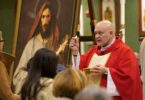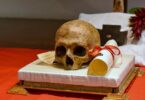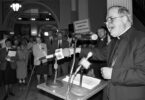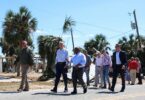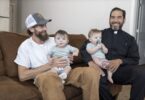
by Dennis Sadowski
WASHINGTON (CNS) — Native American tribal representatives are partnering with Catholic dioceses and religious congregations in uncovering vast amounts of information about the church’s role in operating residential schools that for more than a century worked to assimilate Indigenous children into white society.
Known as the Catholic Native Boarding School Accountability and Healing Project, or AHP, the effort is helping church institutions learn about their past and aiding Native American communities fill holes in their ancestral history.
The “pain of the realization of the immensity of the harms caused,” motivated Sister Susan Torgersen of Minneapolis to join the effort as a member of its coordinating team and its Religious Accompaniment Subcommittee working with religious congregations of women and men.
She said the AHP seeks to work toward accountability by Catholic institutions’ and to promote healing among both Indigenous tribes and Catholic entities.
“As church, we owe our Native brothers and sisters what it takes in terms of reparations, in terms of healing. I believe we have to do this in a listening way,” explained Sister Torgersen, who said her religious community, the Congregation of St. Joseph, did not operate any of the schools.
The work ahead must include Native American representatives in discerning how to carry out the task of searching thousands of pages of decades-old records in diocesan and congregational archives and how to share what is uncovered with tribal communities, those connected to the research process told Catholic News Service.
“One of the things that’s really important in this effort is this is not something that many Native people need more information on. This is part of our family history. The real gap is the lack of awareness of non-Native people across the country,” explained Maka Black Elk, executive director for truth and healing at the Jesuit-sponsored Red Cloud Indian School at Pine Ridge Indian Reservation, South Dakota.
“What I have suggested to the AHP is to build more awareness, to engage the non-Indigenous Catholic community and enter into this with an open heart and mind,” he said.

Such painstaking research has taken on added significance in the past year since the U.S. Department of the Interior began studying Native and Indigenous boarding school operations covering the period from 1819 to 1969.
In a first-of-its-kind report released May 11, the department said hundreds of boarding schools supported by the U.S. government sought to forcefully assimilate Native American and Indigenous children into white society.
The report identified 408 schools in 37 states or former territories that tens of thousands of children were forced to attend during a time period that largely coincides with the forced removal of many tribes from ancestral lands. It also said there are at least 53 marked or unmarked burial sites associated with the schools.
The federal government directly ran many of the schools and contracted with Catholic, Protestant and other churches to operate others, the report said. About 50% of the schools received support or involvement from religious institutions or organizations.
Interior Secretary Deb Haaland, who is Laguna Pueblo and a Catholic, commissioned the report last June by establishing the Federal Indian Boarding School Initiative to undertake a comprehensive review of the troubled legacy of federal boarding school policies.
Conditions varied in the schools, with some students reporting positive experiences while others lived under “systematic militarized and identity-alteration” practices meant to assimilate them into white society, the report said. School leaders renamed children with English names, cut their long hair, and discouraged or prevented the use of Indigenous languages, religions and cultural practices, it said.

Even before Haaland commissioned the report, religious communities and dioceses began digging through archived records to determine the depth of their role in school operations.
And in a letter sent last November, two U.S. bishops urged fellow prelates to cooperate with any request from the federal government in its investigation into alleged abuses at the schools operated by church entities.
Archbishop Paul S. Coakley of Oklahoma City, who chairs the U.S. Conference of Catholic Bishops’ Committee on Domestic Justice and Human Development, and Bishop James S. Wall of Gallup, New Mexico, the past chairman of the bishops’ Subcommittee on Native American Affairs, also encouraged bishops to consider reaching out to local tribal leaders and begin a dialogue about any schools that were located in a diocese.
The USCCB is a participant in the AHP. Father Michael Carson, assistant director of Native American Affairs at the conference, regularly attends the organization’s meetings.
Father Carson explained that the involvement stems from a new pastoral plan, part of which calls for reconciliation with Native Americans over the boarding schools. “We’re looking to opportunities to promote healing and reconciliation,” he said.
While the USCCB or its predecessor organizations never operated any school, the bishops’ Subcommittee on Native American Affairs wanted to address the painful history as a step in gaining the trust of Native people, Father Carson said.
The AHP came together about a year ago, emerging from other such efforts among Catholics, including Catholics for Boarding School Accountability. Brenna Cussen Anglada, who with her husband runs a Catholic Worker movement farm in southwestern Wisconsin, said the role of Catholic organizations in school operations is vital to understand.
Catholics for Boarding School Accountability last fall put together a four-part webinar series to help religious congregations understand how they can work with Native communities in the quest for healing and reconciliation. Cussen Anglada said about 300 people joined each online session.
Ensuring that Indigenous people are consulted throughout the research endeavor was a primary message of the series, she said.
“Records are scattered all over,” she told CNS. “Many congregations and dioceses don’t know they have them. We don’t want to dump hundreds of thousands of paper records on a [Native American] nation. It’s important to ask the Native communities what they want to do with them.”
Cussen Anglada is working with Veronica Buchanan, executive secretary of the Archivists for Congregations of Women Religious and a member of AHP’s Archives Subcommittee, to secure grant funding to complete the assembly of a list of Catholic boarding schools and burial grounds.
Buchanan said the funding being sought from the National Historical Publications and Records Commission would be used to publish in late 2024 a list of schools, their geographic and diocesan locations, the affiliated religious communities, and other information to help Native Americans connect and know to where long-ago family members were taken.
“It will be as comprehensive as possible,” she said, expecting that as many as 1,000 more schools will be identified as the research by various organizations continues.
In addition, the archivists’ group has developed a resource guide for religious congregations. It outlines the role of archives in truth and healing, steps congregations can take to initiate their own review of records and how to balance access to records and confidentiality.
The AHP is sponsoring a webinar June 6 in partnership with the Canadian Conference of Catholic Bishops. The event will feature a conversation with Archbishop Donald Bolen of Regina, Saskatchewan, and members of the Indigenous delegation that met with Pope Francis at the Vatican in March. Black Elk in Pine Ridge will facilitate the conversation.
The Canadian Catholic Church is on its own path to reconciliation and healing alongside Indigenous people since the identification of burial sites near residential schools in British Columbia and elsewhere in 2021.
Black Elk said such conversations are important for the Catholic Church as it seeks to reconcile with its mistreatment of Native peoples.
“The Catholic Church has a great deal of work it needs to continue to do to atone for its historic involvement of the harmful process of colonization of Native peoples,” he told CNS.
“For people who are victims, victims need to heal. That’s their path to take,” Black Elk said. “Healing also needs to happen for perpetrators of historic harm. That’s where it gets complicated. Yes, many of the people today in this situation aren’t the people who committed the atrocities in years past, nor have the direct burden.
“But we have this need as an institution to heal ourselves and be what our faith actually calls us to be all the time. Healing has to happen for the church and non-Indigenous people who carry the history as descendants.”
He also called for non-Indigenous people to be “open to learning what the experience was of other people.”
“It’s not a hard task. It’s one we can’t be closed to. If we’re closed to the experience of the people then we’re closed to God.”

